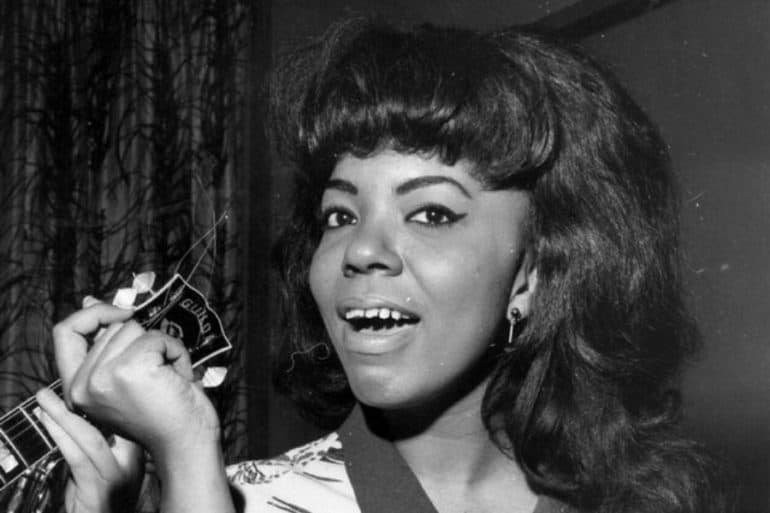We all love a good “rags to riches” story. It can be so inspiring to read of someone who has overcome a tough start and then become a success in their chosen walk of life. Mary Wells did just that, rising from a childhood dogged by ill-health and poverty to being dubbed the ‘first lady of Motown.’
Mary Esther Wells was born in 1943. She rarely saw her father and was brought up single-handedly by her mother. With two siblings to provide for, the family never had much money, and daily life was a struggle.
At the age of 2, Mary was an unfortunate victim of spinal meningitis. As a result, she had to cope with partial blindness, partial deafness and was temporarily paralyzed. When she was 10 years old she developed tuberculosis. Despite her poor health, Mary helped her mother with her job as a cleaner.
For Mary, singing was an escape from the misery of her circumstances. Like many successful African American singers, Mary first performed in church choirs. From there, she began to sing in nightclubs in her native Detroit.
Mary was an ambitious and capable student. She had a career as a scientist in mind, but after graduating she decided to take a chance on a career in music. She saw herself as a singer-songwriter. Her decision was influenced by the success of fellow Detroit musicians Jackie Wilson and the Miracles.
Mary Wells Motown
Mary was lucky to be living in Detroit, as it meant she was able to approach Berry Gordy, the founder of Tamla Records. She had written a song that she thought would be ideal for Jackie Wilson, but Gordy was so impressed when she sang the song to him, that he released it as a single.
Embed from Getty ImagesIt appeared on Berry Gordy’s new Motown label. Released in September 1960 “Bye Bye Baby” charted at number 8 in the R&B charts the following year. It also made a modest showing in the mainstream pop charts.
Mary’s next release was a song written by Mickey Stevenson. Titled “I Don’t Want To Take a Chance,” it broke into the Top 40, reaching number 33. This made her the first female Motown singer to have a Top 40 single.
Berry Gordy felt that Mary should now get an album together, and late in 1961, it appeared along with a third single “Strange Love.” This single was not a success, and Berry Gordy decided on a change of approach.
He paired Mary up with Smokey Robinson, the Miracles’ lead singer, to be her producer. Success followed, with a string of hit singles including their first hit “The One Who Really Loves You” and “You Beat Me to the Punch.” This song went to number 1 in the R&B chart and to number 9 in the pop music chart. It was also nominated for a Grammy Award in 1963 in the Best Rock & Roll Recording category.
“Two Lovers” was released in late 1962 and was an immediate success. It was Mary’s third consecutive single to reach the Top 10. After selling one million copies it was also her first gold disc.
A second album also appeared in 1962 and took its title The One Who Really Loves You from the hit single. Unlike her first album, this one was a success, reaching number 8 on the pop album chart. Although Mary was not Motown’s first female signing, she certainly was the most successful at this time. She was now truly ‘the first lady of Motown’.
During the mid-1960s Mary was at the top of her profession. Hit followed hit, with “Laughing Boy,” “Your Old Standby,” “You Lost the Sweetest Boy,” and “What’s Easy for Two is So Hard for One.” “You Lost the Sweetest Boy” introduced the mega-successful writing team of Holland-Dozier-Holland to the pop music world.
The success continued with “Operator,” “Two Wrongs Don’t Make a Right,” “What Love Has Joined Together,” and other songs originally recorded as B’ sides. Their popularity ensured that Mary Wells continued to score hits in rapid succession.
Mary Wells – My Guy
1964, however, was to be a very special year for Mary. She recorded what was to be her most successful hit single and the song she came to be best known for. “My Guy” was written by Smokey Robinson and hit number 1 on the R&B chart as well as the pop chart.
It was also among the first Motown records to break into the UK chart. Mary Wells became an international star and a favorite of The Beatles. She traveled to the UK and toured with The Beatles as the opening act at each of their gigs.
Mary became good friends with The Beatles and later released an album in tribute. Called Love Songs to the Beatles it showed Mary’s enthusiasm for The Beatles and their music.
1964 might have been Mary’s most successful year, but it was also a year of change. Issues began to arise between her and Motown Records. She felt that groups like The Supremes were being promoted at her expense, and she challenged Berry Gordy, demanding that she be allowed to leave Motown.
The argument ended up in court, and although Mary won and was released from her contract, it was stipulated that she could no longer receive royalties from her Motown recordings.
Mary left Motown Records at the beginning of 1965 and promptly signed with 20th Century Fox Records. Just as she was recording new material for her first album with the label, her tuberculosis returned and she was forced to take a break.
She remained bedridden for weeks, and her recovery was slow. When she returned to the studio, she finished the album which was called Mary Wells. Only one track “Use Your Head” made it into the Top 40. The album was a flop, as was the tribute album to The Beatles. Mary left 20th Century Fox later in the year and signed with Atco Records, which was owned by Atlantic Records.
In 1966 Mary scored one more hit with “Dear Lover.” Issues again surfaced with her record company, and she left Atco. Seeking a change of direction, Mary tried to establish herself in movies. She only managed one cameo role, and so returned to her music career. In 1968 she signed with Jubilee Records, and with them, managed to achieve chart success with “The Doctor.”
Mary Wells Changes Her Record Label
In 1970 she parted company with Jubilee and signed with Reprise Records. Two singles were released, but neither made the charts. However, “My Guy” was re-released in the UK, and Mary agreed to promote it. This she did, appearing on the British TV program Top of the Pops. “My Guy” was a hit, and Mary seemed to be back in the public eye.
Mary was now married to Cecil Womack and decided in 1974 to quit the music industry to devote time to her family. After her divorce in 1977, Mary began performing again and signed with Epic Records. On her new label, she released the album In and Out of Love in 1981. One single from the album scored major chart success, and that was “Gigolo,” a disco-style production.
The album itself, however, was not a chart success. “Gigolo” was to be her last chart success. One more album was released on the Epic label, which was These Arms. It was not successful, and Mary did no more recording for Epic.
She left the label in 1983 and did some recording for minor labels. This brought her to the attention of a different market, and she enjoyed a period of success as a touring singer. With her singing career waning, Mary did attempt some business ventures, but none were successful.
The Personal Life Of Mary Wells
Mary Wells married twice. Her first husband was a singer named Herman Griffin. They were both teenagers when they married and problems set in almost straight away. Divorce ended the marriage in 1963.
The singer-songwriter Cecil Womack was Mary’s second husband. With him, she had three children. The marriage lasted for eleven years, finally collapsing in 1977. Partly, this was due to Mary having an affair with Cecil’s brother Curtis, by whom she later had another child.
A failed suicide attempt followed, with Mary turning to drugs in its aftermath. She became addicted to heroin. Mary remained with Curtis Womack until 1990, with their daughter Sugar being born in 1986. Once she became pregnant, Mary quit taking drugs.
Mary Wells’ Death
In 1990, Mary was recording an album for Motorcity Records when her voice began to deteriorate. Doctors realized that she was suffering from laryngeal cancer. The treatment was expensive and Mary soon used up her personal funds. Friends from the music industry helped by donating funds and holding a benefit concert to aid her in her recovery.
In 1992, Mary’s cancer returned and she was hospitalized with pneumonia. Much weakened, she died on 26 July at 49 years of age.
Her good friend and musical collaborator, Smokey Robinson, read a moving eulogy at her funeral. After which she was laid to rest in Glendale’s Forest Lawn Memorial Park, a short distance away from long-time family friend and renowned musician, Sam Cooke.
The Legacy Of Mary Wells
Mary Wells was a true star, that shone brightly during the 1960s. She was a pioneer in the music industry and helped establish Motown Records as leaders in the world of R&B music.
Motown Records’ aim was to produce black music that would find an audience among the young people of America. In that, they succeeded, but Mary also trailblazed a way for female singers and musicians to follow her example.
Her eminence as a performer was recognized by the Rhythm & Blues Foundation with a Pioneer Award in 1989. After her death, “My Guy” was honored with a 1999 induction into the Grammy Hall of Fame.
In 2006 she took her place among inductees to the Michigan Rock And Roll Legends Hall of Fame. In 2017, the National Rhythm & Blues Hall of Fame also honored her.
For a visual peek into the life of Mary Wells, check out this video from the team at Unsung.
Frequently Asked Questions
Who Was Mary Esther Wells?
Mary Wells was an American singer and one of the first stars of the soon-to-become legendary Motown Records.
Why Did Mary Wells Leave Motown Records?
Mary Wells left Motown Records due to a contractual dispute. She felt that earnings were being withheld from her and used to promote other artists, including The Supremes.
When Did Mary Wells Die?
Mary Wells passed away in 1992.
What Was Mary Wells’ Most Popular Song?
Easily Mary Wells’ most popular song was the single “My Guy”. You can check it out in the video in this article.
Who Were Mary Wells’ Children?
Mary Wells had four children from two marriages: Harry, Stacy, Sugar and Cecil Jr.
The Rocks Off Selected Songlist Of Mary Wells
| Year | Song Name | Chart Position |
| 1962 | “The One Who Really Loves You” | #8 US |
| 1962 | “You Beat Me To The Punch” | #9 US |
| 1962 | “Two Lovers” | #7 US |
| 1963 | “Laughing Boy” | #15 US |
| 1963 | “You Lost The Sweetest Boy” | #22 US |
| 1963 | “What’s So Easy For Two Is So Hard For One” | #29 US |
| 1964 | “My Guy” | #1 US, #5 UK |
| 1964 | “Once Upon A Time” | #19 US |
| 1964 | “What’s The Matter With You Baby?” | #15 US |
| 1965 | “Never, Never Leave Me” | #15 US R&B |
| 1966 | “Dear Lover” | #6 US R&B |
| 1968 | “The Doctor” | #22 US R&B |
| 1981 | “Gigolo” | #1 US Disco |
Similar Stories…
- Claudia Lennear – The Soul Singer You’ve Probably Never Heard Of
- Marsha Hunt – The Complete Story of Mick Jagger’s “Brown Sugar”
- Betty Davis – The Revolutionary Funk Singer Ahead of Her Time
- Jayne Kennedy – Hollywood’s Female Trailblazer
- The Alice Cooper Fact Sheet – 5 Things You Need To Know - January 12, 2023
- Everybody Knows The Words, But What Is Hotel California About? - April 29, 2022
- What Is The Meaning Of Stairway To Heaven: Led Zeppelin’s Amazing 1971 Musical Epic? - April 24, 2022


